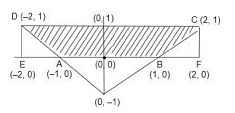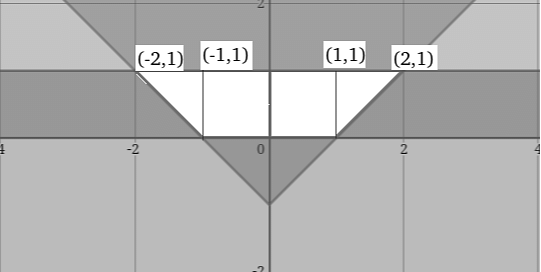The area of the region satisfying the inequalities \(|x|-y≤1,y≥0\) and \(y≤1\) is [This Question was asked as TITA]
- 3 Square units
- 2 Square units
- 5 Square units
- 4 Square units
The Correct Option is A
Approach Solution - 1
The graph of \(|x|-y≤1,y≥0\) and \(y≤1\) is as follows:
To find the area of quadrilateral ABCD, we subtract the areas of triangles EAD and BFC from the area of rectangle EFCD:
Area of ABCD = Area of EFCD − Area of △EAD − Area of △BFC
Using the formula:
\( \text{Area of ABCD} = EF \times FC - \frac{1}{2} \times EA \times ED - \frac{1}{2} \times BF \times FC \)
Substituting the values:
\( = 4 \times 1 - \frac{1}{2} \times 1 \times 1 - \frac{1}{2} \times 1 \times 1 \)
\( = 4 - 0.5 - 0.5 = 3 \) square units
Final Answer: \( \boxed{3} \) square units
Approach Solution -2

Area of the region contained by the lines | x | -y ≤ 1, y ≥ 0 and y ≤ 1 is the two triangle and the one rectangle in white region.
So, we have calculate these area to get the total area.
Total Area = Area of rectangle + 2 × Area of triangle
= \(2+(\frac{1}{2}\times2\times1)=3\)
Therefore, the correct option is (A) : 3 Square units.
Top Questions on Geometry
- Given below are two statements :
Statement I : The perimeter of a triangle is greater than the sum of its three medians.
Statement II : In any triangle ABC, if D is any point on BC, then \(AB + BC + CA>2AD\).
In the light of the above statements, choose the correct answer from the options given below : - ABCD is a rectangle where points C and D have coordinates (−2, 0) and (2, 0), respectively. If the area of the rectangle is 24, what is the best way to describe the equation of the line AB?
- Out of the following which is a Pythagorean triplet ?
- Let the volume of a metallic hollow sphere be constant. If the inner radius increases at the rate of 2 cm/s, find the rate of increase of the outer radius when the radii are 2 cm and 4 cm respectively.
- A solid trophy, consisting of two parts, has been designed in the following manner: the bottom part is a frustum of a cone with the bottom radius 30 cm, the top radius 20 cm, and height 40 cm, while the top part is a hemisphere with radius 20 cm. Moreover, the flat surface of the hemisphere is the same as the top surface of the frustum. If the entire trophy is to be gold-plated at the cost of Rs. 40 per square cm, what would the cost for gold-plating be closest to?
Questions Asked in CAT exam
- A loan of Rs 1000 is fully repaid by two installments of Rs 530 and Rs 594, paid at the end of the first and second year, respectively. If the interest is compounded annually, then the rate of interest, in percentage, is:
- CAT - 2025
- Interest
- A value of $c$ for which the minimum value of $f(x) = x^2 - 4cx + 8c$ is greater than the maximum value of $g(x) = -x^2 + 3cx - 2c$, is:
- CAT - 2025
- Linear & Quadratic Equations
- In a $\triangle ABC$, points $D$ and $E$ are on the sides $BC$ and $AC$, respectively. $BE$ and $AD$ intersect at point $T$ such that $AD : AT = 4 : 3$, and $BE : BT = 5 : 4$. Point $F$ lies on $AC$ such that $DF$ is parallel to $BE$. Then, $BD : CD$ is:
- CAT - 2025
- Geometry
- In the sequence 1, 3, 5, 7, ..., k, ..., 57, the sum of the numbers up to k, excluding k, is equal to the sum of the numbers from k up to 57, also excluding k. What is k?
- CAT - 2025
- Arithmetic Progression
- Find the number of integer pairs (x, y) that satisfy the following system of inequalities:
\[ \begin{cases} x \geq y \geq 3 \\ x + y \leq 14 \end{cases} \]
- CAT - 2025
- Linear & Quadratic Equations